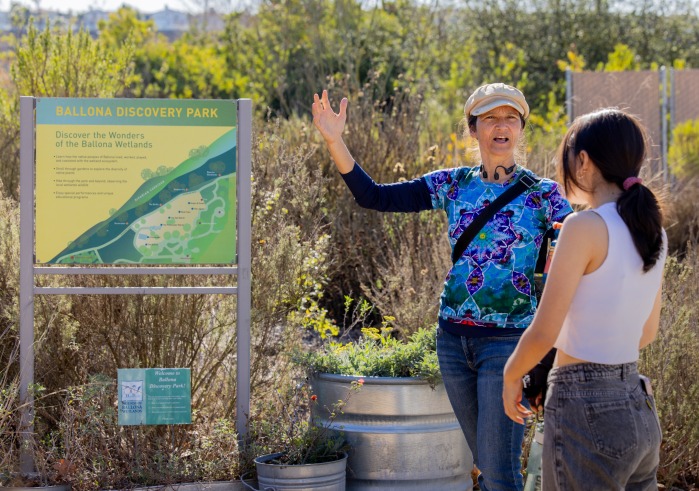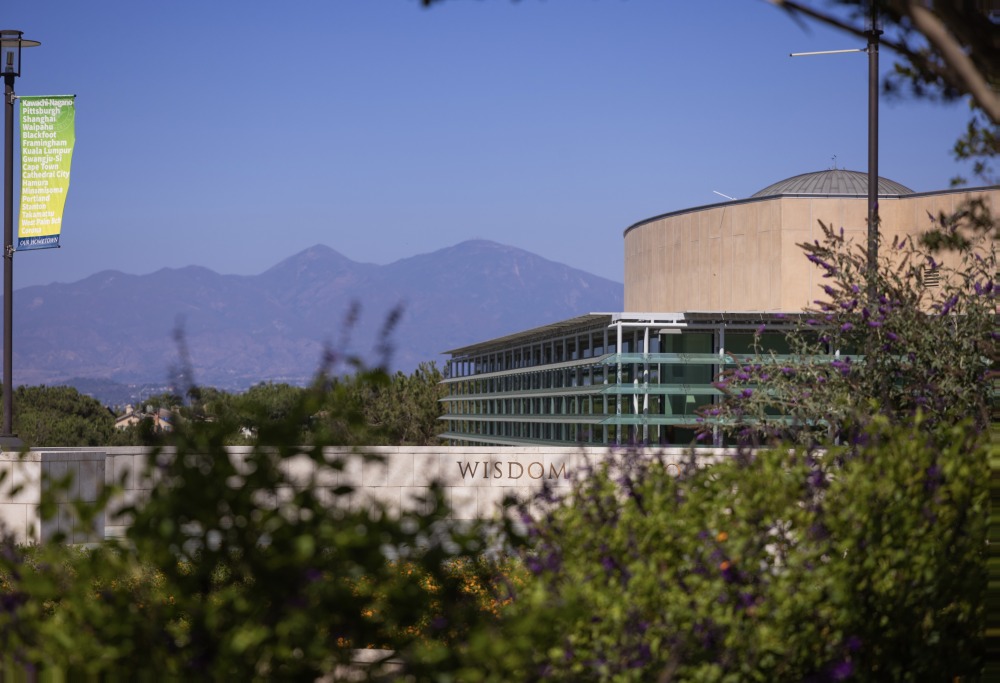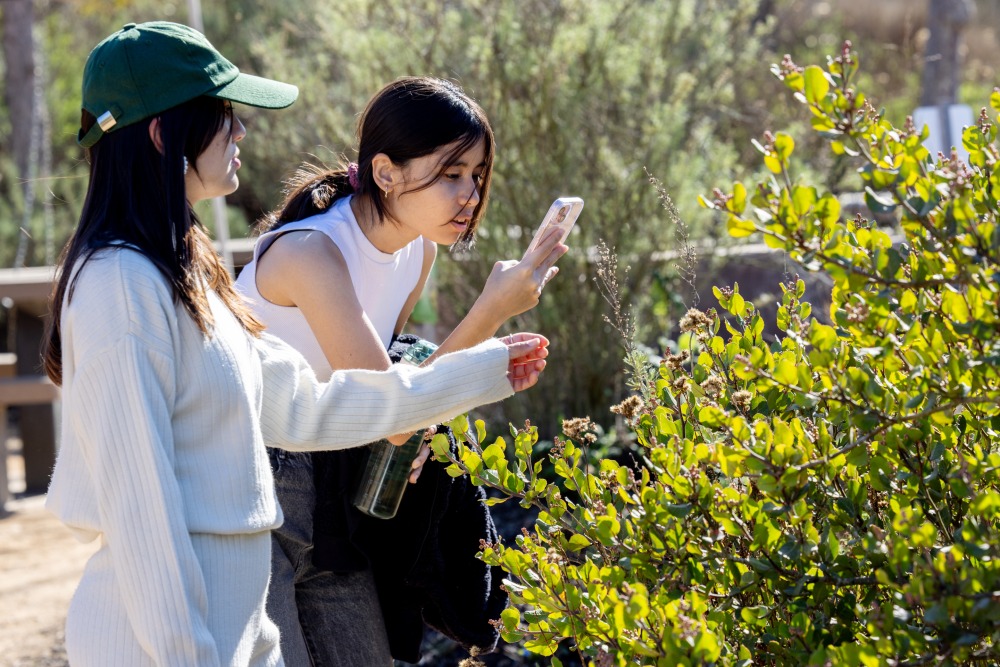Environmental Studies: Bridging Disciplines, Fostering Leaders in Sustainability

Many people would assume that a software engineer, a wildlife conservationist, a city planner, a lawyer, and a scientific illustrator have very different undergraduate degrees. But in reality, all these careers — and many more — are possible with SUA’s B.A. in Liberal Arts with a concentration in environmental studies.
One of five broad areas of focus that students may choose at SUA, the Environmental Studies Concentration includes courses in ecology, urban planning, geography, earth and ocean sciences, and environmental policy and management. There are also cross-listed courses that examine intersections between the environment and philosophy, literature, music, and economics. The ES Concentration goes beyond learning about the environment from a scientific perspective; it also provides a thorough background in the social, cultural, political, and technological issues that affect the way humans interact with the Earth.
“It’s the challenge,” said Deike Peters, associate professor of environmental planning and practice, “of thinking through how we might live more sustainably, more equitably, more mindfully, and with better stewardship of this planet.” An environmental urbanist, Peters teaches classes on sustainable cities, ecocinema, environmental movements, and informal urbanization in the Global South.
Vitória Souza e Robles ’25, who is from Taubaté, Brazil, said that concentrating in environmental studies has allowed her to develop “a global idea of how the world works in relation to the environment.” She has especially enjoyed diving deep into environmental management case studies in a class taught by George Busenberg, associate professor of environmental management and policy.
Faculty members in the ES Concentration continually update their curriculum to incorporate current events and modern technologies. “What I try to do in my teaching,” said Busenberg, who also teaches environmental policy and law, public and environmental health policy, and disaster and emergency management, “is bring the real world into the classroom.”
And ES classrooms often expand into the great outdoors. In a botany class with Robin Fales, assistant professor of marine ecology, students might take a walk in a local wilderness park to perform an ecological survey. “I strongly believe in learning by doing,” said Fales, who takes a hands-on approach to teaching environmental conservation and restoration. In addition to courses on ecology and plant life, she teaches classes in sustainable aquaculture, ocean science, and data and statistics, among others.
Monika Calef, associate professor of physical geography and director of the ES Concentration, believes environmental studies provide critical knowledge that everyone should understand — especially in the face of climate change. And while the current and future effects of the climate crisis can feel overwhelming, Peters argues that learning about how we can contribute to global solutions is ultimately uplifting.
“There’s a lot of hope and can-do that we convey in our classes,” she said. “You should come out of an environmental studies class feeling more hopeful and empowered, knowing there are ways you can make an impact.”
Critical Knowledge for Global Citizens: Why Alumni Chose Environmental Studies
The ES Concentration fulfills one of SUA’s founding principles: to foster leaders for the creative coexistence of nature and humanity. This principle is fundamental to the university’s mission to cultivate global citizens. “Peace building,” Peters said, “doesn’t happen without building peace with the Earth.”
Many ES alumni cited the climate crisis as the primary reason they chose this concentration. Koichi Ito ’19, who is from Tokyo, Japan, is especially concerned about the impact of climate change on social issues, as climate-related disasters disproportionately harm the health and safety of the most resource-stressed communities.
“I wanted to contribute to the mitigation of anticipated catastrophes,” Ito said, “even if it was a tiny fraction of what it takes to solve the problem.”
Some alumni pursued environmental studies because they had seen the consequences of climate change and rapid, poorly managed development in their own hometowns.
“Growing up in rural Nepal,” said Anjan Rana Magar ’23, who is from Lamjung District, “I witnessed the devastating impacts of natural disasters like earthquakes and flooding on local communities. During my high school years in Kathmandu, I also became increasingly concerned about issues such as air pollution and urban congestion.”
ES students are frequently driven by a determination to protect wildlife and preserve the beauty of natural landscapes. MacKenzie Kermoade ’19 is from Everett, Washington, where she developed a deep appreciation for the Salish Sea and its marine ecosystem. Around the time she was applying for college, Kermoade said, she “started thinking a lot about the human systems that interfaced with the sea,” such as her hometown and its naval station. “I thought the ES Concentration at SUA might let me study that confluence,” she said.
Similarly, Michelle Boralessa ’23 from Framingham, Massachusetts, was drawn to the ES Concentration because climate change has affected the lush, tropical flora and fauna in Sri Lanka, where she spent many childhood summers visiting her grandparents. “Sri Lanka,” Boralessa said, “is already seeing major climatic shifts, much to the detriment of the island’s public health and biodiversity … I wanted my career to contribute to protecting populations around the world who will be most vulnerable.”
The ES Concentration prepares SUA students to do exactly that, whatever field they enter after graduation. Many new jobs and career opportunities will arise as the world addresses multifaceted environmental issues and transitions to renewable energy and more sustainable systems.
“The ES Concentration,” Busenberg said, “is specifically designed to prepare students for future challenges and opportunities on a global scale.”
Cultivating Curiosity and Career Readiness: The ES Skill Set
The concentration does an excellent job of preparing students with the skills they will need for graduate studies and professional careers. An important part of that is encouraging students to take an active part in their own learning.
“Most of my ES classes,” Kermoade said, “were rich with rigorous readings, Socratic, student-centered dialogue, and hands-on projects.”
Busenberg places a strong emphasis on independent initiative in his courses and frequently assigns term papers. When students learn to choose their own paper topics, do independent research, and write clearly and effectively, he said, they are preparing for project management in the professional world.
Research, writing, and presentation skills are also crucial for graduate school. ES alumni have gone on to graduate programs in biology, geospatial science and technologies, environmental law, public policy, business, public health, environmental management, landscape architecture, urban planning, and even artificial intelligence.
ES students also have the opportunity to learn how to use Geographic Information System (GIS) technology, which maps, analyzes, and manages geographic data. Kyle Chin ’17, who didn’t know what GIS was prior to taking an introductory course with Calef, was immediately fascinated by this computer software and its capabilities.
“I fell in love with GIS,” Chin said, “because it is at the crossroads of geography, urban planning, and technology … It is a powerful tool that enables people to make spatially informed decisions across various industries.” Chin, who is from Kuala Lumpur, Malaysia, now works as a product engineer at Esri, a leading multinational GIS software company. “The product I work on,” he explained, “is used by professionals in the fields of transportation and natural resource management.”
GIS skills have also played a critical role in the career paths of other ES alumni. Rana Magar leveraged these skills to land an internship as a remote sensing assistant at NASA as part of the DEVELOP program. Megan Cheong ’19, who is from Auckland, New Zealand, currently works for the New Zealand government as a geospatial analyst in the Ministry for Primary Industries.
“Some examples of tasks I would do,” Cheong said, “are creating dashboards to show where pests are found at airports, developing a mobile data collection tool for users to conduct forestry surveys, and preparing an online map showing flooded areas and critical infrastructure for situational awareness during an emergency.”
In addition to skills, ES students acquire a wide basis of knowledge. This prepares them very well for the professional world, Calef said, because “they can be bridges between teams from various disciplines who work together.” Dominic Goshert ’17 from Phoenix, Arizona, found that the concentration gave him a solid foundation for his current role as a botanical monitoring specialist at the Center for Environmental Management of Military Lands, where he manages a team that works to preserve endangered plant populations in the Pōhakuloa Training Area in Hawaii.
“The ES Concentration,” Goshert said, “introduced me to the fundamental skills needed to jump-start my career. The multidisciplinary approach to the curriculum gave me the confidence to engage with stakeholders from diverse professional backgrounds and varying levels of familiarity with conservation management projects.”
The breadth of subject area knowledge ES students acquire also allows flexibility in their career paths, since they are not boxed into a single profession after graduation. “Because this concentration is nested within a liberal arts school,” said Frances DePhillips ’25, a current ES student from Boise, Idaho, “we are inherently connecting so many different disciplines, which creates very open-minded thinkers that can adapt to many different careers, jobs, or professional environments.”
This willingness and ability to learn and adapt is key to success in any field, but particularly those related to environmental studies, where new technologies emerge all the time. “The most important thing I teach my students,” Busenberg said, “is how to learn independently and rapidly so they can adapt to a swiftly changing world throughout their lives.”
ES Capstones: Researching Real-World Problems, Launching Career Journeys
In their senior year, SUA students work on a capstone, an independent research project on a topic of their choice. When students pursue what they are passionate about in the capstone, it often enables them to define their educational or professional goals as well.
Kermoade’s capstone, for example, examined “the management of marine mammals in two coastal Arctic Indigenous groups, the Iñupiat in Alaska and the Kalaallit in Greenland,” both of which traditionally rely on marine mammals for subsistence. She researched how domestic and international policies influenced each group’s practices, an exercise in interjurisdictional analysis that would be relevant to her graduate studies. She earned a Master of Laws degree in global environment and climate change law from the University of Edinburgh in 2020. Since 2022, she has worked for the International Council for the Exploration of the Sea in Denmark, where she uses her environmental law degree to support the organization’s marine science research.
For her capstone, Boralessa researched malaria vector control programs in Sri Lanka and Nigeria, analyzing the benefits and drawbacks of using pesticides to reduce the mosquito population. She is now in her final year of the Master of Public Health in the Environmental Health Sciences program at the University of Massachusetts, Amherst. She currently works as a research assistant and is contributing to a report on foodborne parasite infections for the Food and Agriculture Organization of the United Nations.
Other ES capstones have covered important topics in urban planning, facilitating students’ career paths in related fields. Ito examined dedicated bus lane projects in Jakarta, Indonesia, analyzing how political commitment drives progress in sustainable development. He is now in a doctoral program at the National University of Singapore, where he researches how urban design can encourage people to adopt more sustainable modes of transportation. He is also starting a new position as a visiting researcher at the University of Texas at Austin.
Corporate sustainability has been another fruitful area of research for ES seniors. Rana Magar harnessed his GIS skills to map groundwater use in California’s Central Valley and highlight concerns about the water-intensive nut production industry. Chloe Ballard ’19 studied the sustainability initiatives of several large U.S.-based corporations, discerning when companies took concrete actions or used greenwashing to avoid meaningful change. Originally from Corbett, Oregon, she went on to earn an M.B.A. in entrepreneurship at EM Strasbourg Business School in France. She currently works as a sustainability coordinator for the town of Windsor, California.
Environmental studies capstones can also exemplify the inherently interdisciplinary nature of education at SUA. For her capstone, Hannah Jakob ’21 from Missoula, Montana, applied skills she learned in a Learning Cluster on scientific illustration taught by Professor of Studio Art Anne Pearce. Jakob researched marine species native to British Columbia and produced a collection of “scientific illustrations and an educational pamphlet that explored the delicate balance between marine biodiversity and human activity.” Jakob is currently pursuing a Ph.D. in art education at Concordia University in Montreal. Outside of her graduate studies, she has created educational materials for the National Wildlife Federation and Wildlife Works. “The ES Concentration,” Jakob said, “allowed me to find my niche in the illustration and academic world.”
“Dive Into the Opportunities”: ES Faculty, Students, and Alumni Share Their Advice
The SUA environmental studies community has a lot of helpful advice for current and future ES concentrators. The most common recommendation is to go to office hours and talk with your professors one-on-one.
“If you get stuck or have questions,” Calef said, “we are delighted to talk to students.”
Peters also stressed that ES faculty are very open to mentoring students, and she encourages students to come talk with their professors early on in their time at SUA. “Don’t wait too long to get to know us,” she said. “Everybody is really approachable.”
Furthermore, Peters emphasized the importance of connecting what you’re learning in the ES Concentration with your experiences off campus, especially your semester abroad. For example, Peters is supervising Souza e Robles’ senior capstone project, which grew out of her internship with the forum theater group Kaddu Yaraax while studying abroad in Senegal. She is researching how the group’s participatory performances, which are inspired by Augusto Boal’s Theater of the Oppressed, have engaged the local population in environmental issues around Dakar’s highly polluted Hahn Bay. Peters said this exemplifies the interdisciplinary environmental thinking and activism that arises when students connect their classroom learning with their extracurricular experiences.
When it comes to choosing your ES courses, SUA senior DePhillips recommended meeting with the director of the concentration to learn more about future course offerings and start envisioning your journey within the concentration. Alumnus Chin pointed out that SUA’s student-centered approach empowers students to suggest courses that can help them reach their educational goals. During his time at SUA, he petitioned for an Advanced GIS course that allowed him to fulfill the prerequisites for an M.S. in GIS at California State University, Long Beach.
Chin’s experience relates closely to Busenberg’s advice about picking your classes: “Align your choice of courses with your professional aims,” he said. “The ES Concentration offers a wide variety of professional-grade courses.” Alumnus Goshert also suggested approaching the concentration with an eye on your future.
“Start looking into the kinds of jobs and career paths you want to pursue after your studies,” Goshert said, “and use those descriptions to help guide your course selection … It’s important to communicate with your advisors about the path you wish to shape, though don’t dismiss the usefulness of learning from a diverse list of disciplines and professors.”
Faculty, alumni, and current students all advised keeping an open mind and taking courses in multiple subject areas to develop a well-rounded understanding of environmental studies.
“Environmental issues are deeply and widely rooted in society,” Ito said, “so it is imperative to gain many perspectives on an issue, which may include cultural understanding, statistical analysis, or international relations.”
Alumna Jakob encourages ES students to “dive into the opportunities SUA offers” like interdisciplinary projects and hands-on research. “Stay curious,” she said, “embrace collaboration, and don’t be afraid to carve out a unique path that combines your passions.”
If you’re considering the ES Concentration but are not yet sure it’s the right path for you, it may be helpful to consider the wide range of subjects you will have the opportunity to study.
“The beauty of this concentration,” Kermoade said, “is that it’s not all science, and it’s not all social studies. It’s really what you make of it. Whether you want to be a GIS tech or a lawyer, an activist or an urban planner, you will find your niche in the ES Concentration. It has something for everyone. If you’re motivated by environmental justice, then this is the concentration for you.”


